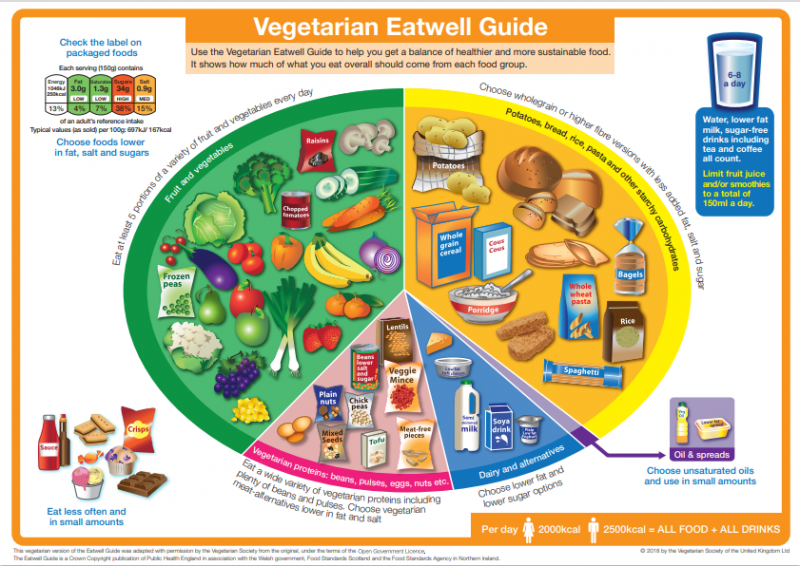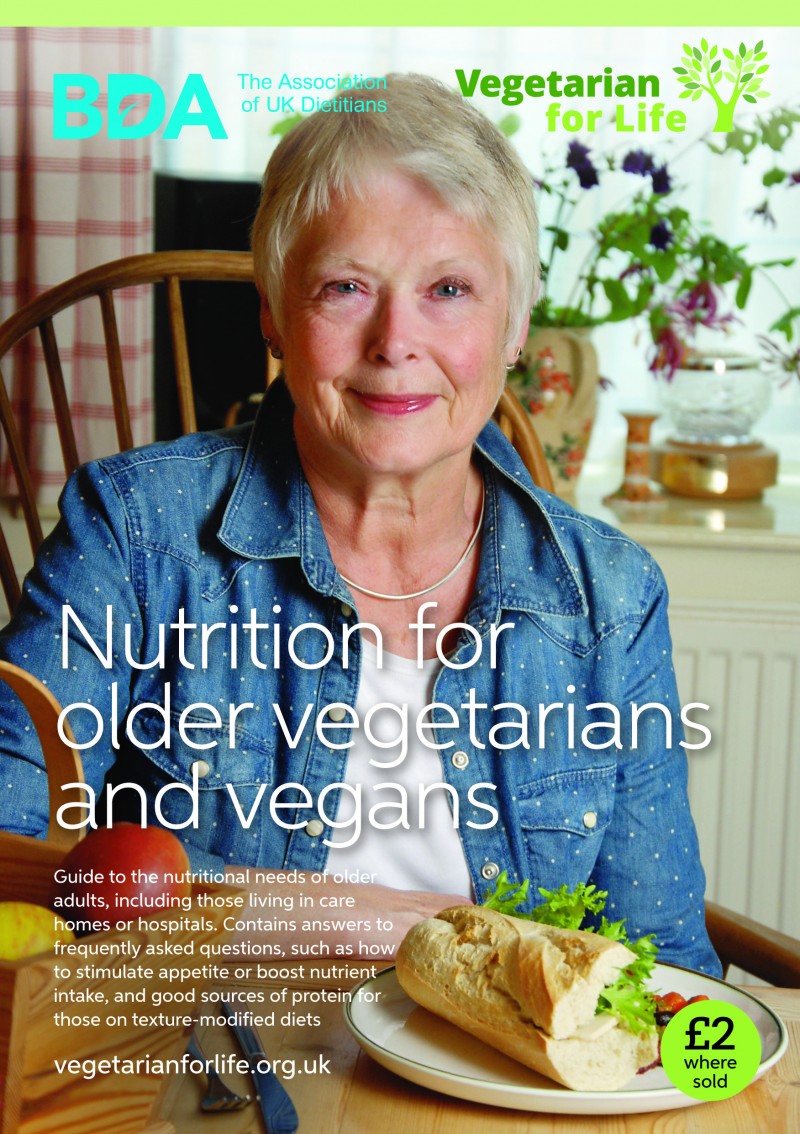Many age-related changes can impact our nutrient intake. Our ability to digest, absorb and use some nutrients can decline with age – as can our sense of taste and appetite.
But although we generally have a lower energy or calorie intake, we still have the same nutrient requirements as younger adults, reports Dietitian, Beth Rougier.
With all these possible changes it’s important to ensure that older adults are maintaining their muscle strength and avoiding unplanned weight loss.
As chefs it’s important that you can provide good quality, nutrient-rich foods for your older vegan and vegetarian (veg*n) residents.

Here are our top tips.
Contents
- Extra considerations for older adults
- Putting it into practice for your veg*n residents
- Vegan Eatwell Plate
- What about protein?
- Getting enough calcium
- Omega 3 fatty acids
- Iron and zinc
- Vitamin D recommendations
- Vitamin B12 recommendations
- Getting enough iodine
- Selenium
- Vegan fortification
- Further information for dietitians supporting older adults
Extra considerations for older adults
- We usually recommend opting for high- fat/-calorie options. For some people that means liberalising previous dietary restrictions, which can be confusing. Explaining the consequences of being underweight and why we are recommending high fat foods can be helpful.
- While general recommendations are to eat higher fibre starchy foods, this may not be the best option for those with a small appetite. These foods tend to be bulkier and require more chewing. White pasta, rice and bread may be easier to eat.
- Find out someone’s preferences for where to eat, and with whom. These factors can have a big impact on our appetite and enjoyment of meals.
- Provide adequate support for those who require it. This could be special equipment, verbal encouragement or assistance with eating and drinking.
Putting it into practice for your veg*n residents
- Use nutrition software to analyse your veg*n recipes so that you’re clear on what they provide, and can provide a well-balanced menu.
- Check with your wholesaler to see what fortified vegan products they stock or where else you could source these from.
- Consult with your dietitian to ensure that you’re providing a well-balanced menu. They can advise where supplements need to be implemented.
Vegan Eatwell Plate

General healthy eating guidelines still apply to healthy older adults but we may need to individualise advice depending on health status.
- Around a third of daily food intake should come from fruit and vegetables – shown in the green section.
- Obtain a third from grains and other starchy foods (yellow section)
- And the last third from protein foods (pink section), calcium containing foods (blue section) and small amounts of oils and fats (purple section)
- Fluid is important for older adults because they are more at risk of dehydration. Provide around 1.6 litres for women and 2 litres for men (10). As well as water include hot drinks such as tea, coffee, hot chocolate, milk and milky drinks, fruit juices and soups.
What about protein?
The UK recommended protein intake is 0.75g per kg of body weight per day. For a 10 stone adult this would be 48g protein per day.
However, in addition to regular exercise, a higher protein intake may help older adults to maintain muscle mass and strength.
This has led some expert groups to develop separate protein recommendations for older adults.
European guidelines recommend aiming for 1–1.2 grams per kg per day (11). For someone weighing 10 stone, or 64 kg, this would be 64–77g protein.
All plant foods contain protein, but particularly good sources include soya products, plant-based meat alternatives, legumes, nuts and seeds. One way to maximise protein intake is to include some protein-rich foods at every meal.

Here are some examples:
- Beans, peas and lentils – in soups, casseroles and curries.
- Soya products, such as tofu or tempeh – in sandwiches, cooked breakfasts or main meals, such as stir-fries.
- Nuts and seeds – added to meals and snacks. Use ground versions or nut and seed butters for those who find it difficult to chew and digest whole nuts and seeds.
- Plant-based meat alternatives, which are often lower in fibre, and may be useful for those on a lower fibre diet.
- Soya milk and soya yoghurts – soya milk is the best choice of plant milk in terms of protein content.
Getting enough calcium
To get 1,000–1,200mg/day we need to aim to consume 3–4 portions of calcium-fortified dairy alternatives a day, in addition to other calcium containing foods.
Most plant milks are calcium fortified, except for organic varieties, so do check on this. A portion is 200ml milk or 125g pot of yoghurt.
Calcium is found in lots of plant foods but notable sources include:
- Calcium set tofu. Check the ingredients to see whether the tofu has been set with calcium.
- Low oxalate greens, such as mustard greens, broccoli and cabbage. Oxalate binds to calcium and reduces the bioavailability, so even though foods like spinach and Swiss chard contain calcium, the calcium is less available so not considered a good source.
Omega 3 fatty acids
We need omega 3 fatty acids from our diet because our bodies don’t produce them. They have anti-inflammatory properties and so are beneficial for cardiovascular health among other things (25).
There are no recommended intakes of omega 3 in the UK, just guidelines to include oily fish in the diet. However, you don’t have to eat fish for omega 3. It’s found in plant foods in the form of alpha-linolenic acid (ALA) and our bodies can convert this to the longer chain omega 3s EPA and DHA.
EPA and DHA are the omega 3s that are found in oily fish, that have been shown to have cardioprotective effects.
Plant sources of omega 3
- seeds such as linseed, hempseed or chia seeds
- nuts – especially walnuts
- oils such as flaxseed, walnut, soybean or rapeseed oil.
Aim for 1–2 portions per day. Ground nuts and seeds or oils will be easier to eat for older adults with chewing and swallowing difficulties or small appetites.
Iron and zinc
Iron and zinc are important for everyone, including older adults (14)(15). Iron deficiency can lead to anaemia, and zinc deficiency reduces our ability to fight infection.
There are no special dietary recommendations for healthy adults, other than to eat a varied diet.
For those who need an increase in their iron intake, there are a couple of recommendations.
- Include vitamin C containing foods or drinks with meals. This has been shown to boost iron absorption.
- Avoid serving tea and coffee with meals because the polyphenols can reduce absorption. Wait 1–2 hours before serving these drinks.
Vitamin D recommendations
In addition to calcium, we also need vitamin D for good musculoskeletal health. Our main source of vitamin D is synthesis by our skin when it’s exposed to sufficient sunlight. Older people have reduced synthesis of vitamin D, hence they are more at risk of lower levels.
Dietary sources of vitamin D can be provided, which include fortified foods such as breakfast cereal, plant-based dairy alternatives, and fat spread. Not all vitamin D is suitable for strict vegans. Vitamin D3 is made from wool fat. However, vitamin D2 or vitamin D3 made from lichen are suitable for vegans.
Vitamin B12 recommendations
Older adults are at a higher risk of vitamin B12 deficiency because of reduced absorption of the vitamin, and inadequate intakes.
In the long term, B12 deficiency can lead to a range of problems, including neurological problems and circulatory health problems, as a result of raised homocysteine (23). So all older plant-based adults need to ensure they have a reliable source of vitamin B12.
Plant foods are not a reliable source of vitamin B12 unless they have been fortified.
The UK recommended intake is 1.5mcg/day, but recommendations are higher for those following a plant-based diet. The Vegan Society recommends aiming for at least 3mcg/day. This can be achieved by eating fortified foods at least twice a day or taking a supplement of at least 10mcg a day or 2,000mcg a week.
Plant foods fortified with vitamin B12 include plant-based milks, breakfast cereals, yeast extract, margarine and nutritional yeast flakes.
Iodine recommendations
Iodine is a mineral used to produce thyroid hormones that are involved in metabolism and growth. It’s a nutrient that can be low in those following a plant-based diet, regardless of age.
The main sources of iodine in the UK are dairy and fish. Iodine is found in plant foods but the amount varies depending on several factors and is generally not enough.
The UK recommended intake is 140mcg/day.
Getting enough iodine
Some plant-based milk- and yoghurt- alternatives are iodine fortified. Having 2–3 portions of these a day will likely meet recommended intakes. These include Oatly and Oatgurt, Alpro chilled plant-based beverages, Marks and Spencer plant-based beverages and Pea M*lk. You can look at the nutritional information to check whether yours is fortified.
Selenium
Lastly, it’s important to mention selenium. This trace element has a range of functions, including protection from oxidative damage and infection (32).
Older adults (7), especially those living in care homes (33), appear to have an increased risk of inadequate intakes or low selenium status. UK recommended intakes for selenium are 75mcg/day for men and 60mcg for women (34).
Selenium recommendations
Plant based sources include nuts, grains, cereals, beans and seeds. The selenium content of Brazil nuts is variable but tends to be high. The selenium content of 4 Brazil nuts ranges between 50–388 µg.
Vegan fortification:
Food first approach
- For people at risk of malnutrition, we usually start with a food first approach. This involves three main strategies to boost dietary intake: little and often, nourishing drinks and fortified foods.
- By little and often we suggest aiming to have three small meals a day and snacks in between meals, with a focus on choosing higher calorie and protein foods.
- Sometimes people with a small appetite find drinks easier to manage than food. So we can offer nourishing options such as milkshakes, homemade smoothies, hot chocolate or milky coffee, fruit juice or fruit smoothies, or fortified soups.
- We can fortify foods, meaning we add extra calories and protein, without increasing the volume. This makes every mouthful as nutritious as possible and over the course of a day the extra nutrients can really add up.
- You can find more information in VfL’s Food fortification for vegans guide, which provides lots of information on snacks and nourishing drink ideas and ways to fortify plant-based meals.
We hope you’ve found this information useful. For any queries or further information, contact training@vegetarianforlife.org.uk or check out VfL's nutrition guide or British Dietetic Association accredited care catering training – a great introduction to catering for your veg*n residents.

Click here for further information for dietitians supporting older adults.
References
- Van Dijk M, Cullum A, Swan G, Peacock E, Fine G, Robinson S, et al. An overview of the Scientific Advisory Committee on Nutrition’s position statement on nutrition and older adults living in the community. Br J Nutr. 2021;126(8):1164–7.
- Lee L, Simpson I. British Social Attitudes: Are we eating less meat? [Internet]. 2016. Available from: http://natcen.ac.uk/our-research/research/british-social-attitudes-are-we-eating-less-meat/
- Appleby PN, Key TJ. The long-term health of vegetarians and vegans. Proc Nutr Soc Nutr Soc. 2016;75:287–93.
- Tong TYN, Appleby PN, Armstrong MEG, Fensom GK, Knuppel A, Papier K, et al. Vegetarian and vegan diets and risks of total and site-specific fractures: results from the prospective EPIC-Oxford study. BMC Med. 2020;18(1):1–15.
- Tong TYN, Appleby PN, Bradbury KE, Perez-Cornago A, Travis RC, Clarke R, et al. Risks of ischaemic heart disease and stroke in meat eaters, fish eaters, and vegetarians over 18 years of follow-up: Results from the prospective EPIC-Oxford study. BMJ. 2019;366(1).
- Public Health England. Government Dietary Recommendations: Government recommendations for food energy and nutrients for males and females About Public Health England. 2016;1–12. Available from: https://www.gov.uk/government/...data/.../government_dietary_recommendations.pdf
- SACN. SACN statement on nutrition and older adults living in the community. 2021;(January):23–4. Available from: www.gov.uk/government/publications/sacn-
- Vegan Society. Healthy eating tips [Internet]. Vol. 279228. 2016. Available from: https://www.vegansociety.com/sites/default/files/uploads/downloads/The Vegan Eatwell Guide_1.pdf
- British Dietetic Association, Friends of the Elderly. Guide to good nutrition and hydration in older age.
- Volkert D, Beck AM, Cederholm T, Cruz-Jentoft A, Goisser S, Hooper L, et al. ESPEN Guideline ESPEN guideline on clinical nutrition and hydration in geriatrics. 2018 [cited 2020 Mar 10]; Available from: https://doi.org/10.1016/j.clnu.2018.05.0240261-5614/://doi.org/10.1016/j.clnu.2018.05.024
- Deutz NEP, Bauer JM, Barazzoni R, Biolo G, Boirie Y, Bosy-Westphal A, et al. Protein intake and exercise for optimal muscle function with aging: Recommendations from the ESPEN Expert Group. 2014 [cited 2019 Nov 26]; Available from: http://dx.doi.org/10.1016/j.clnu.2014.04.007
- Mariotti F, Gardner CD. Dietary protein and amino acids in vegetarian diets—A review. Nutrients. 2019;11(11):1–19.
- Davis B, Melina V. Zinc. In: Becoming Vegan. Book Publishing Company; 2014. p. 190–1.
- Cabrera AJR. Zinc, aging, and immunosenescence_ an overview _ Enhanced Reader.pdf. Pathobiol Aging Age-related Dis. 2015;5.
- Pawlak R, Berger J, Hines I. Iron Status of Vegetarian Adults: A Review of Literature. Am J Lifestyle Med. 2018;12(6):486–98.
- Sobiecki JG, Appleby PN, Bradbury KE, Key TJ. High compliance with dietary recommendations in a cohort of meat eaters, fish eaters, vegetarians, and vegans: Results from the European Prospective Investigation into Cancer and Nutrition-Oxford study. Nutr Res [Internet]. 2016;36(5):464–77. Available from: http://dx.doi.org/10.1016/j.nutres.2015.12.016
- Saunders A V, Craig WJ, Baines SK. Zinc and vegetarian diets. Med J Aust. 2012;1(June):17–22.
- Ross A, JoAnn M, Abrams S, Aloia J, Brannon P, Clinton S, et al. The 2011 Report on Dietary Reference Intakes for Calcium and Vitamin D from the Institute of Medicine: What Clinicians need to know. J Clin Endocrinol Metab. 2011;96(11):53–8.
- British Dietetic Association. Calcium Food Fact Sheet [Internet]. 2021. Available from: https://www.bda.uk.com/resource/calcium.html
- Dorrington N, Fallaize R, Hobbs DA, Weech M, Lovegrove JA. A review of nutritional requirements of adults aged ≥65 years in the UK. J Nutr. 2020;150(9):2245–56.
- Davey GK, Spencer EA, Appleby PN, Allen NE, Knox KH, Key TJ. EPIC–Oxford:lifestyle characteristics and nutrient intakes in a cohort of 33 883 meat-eaters and 31 546 non meat-eaters in the UK. Public Health Nutr. 2003;6(3):259–68.
- SACN. Vitamin D and Health 2016. Sci Advis Comm Nutr [Internet]. 2016;56–116. Available from: https://www.gov.uk/government/publications/sacn-vitamin-d-and-health-report%0Ahttps://www.gov.uk/government/uploads/system/uploads/attachment_data/file/537616/SACN_Vitamin_D_and_Health_report.pdf
- Pawlak R. Is Vitamin B12 Deficiency a Risk Factor for Cardiovascular Disease in Vegetarians? Am J Prev Med [Internet]. 2015 Jun 1;48(6):e11–26. Available from: https://doi.org/10.1016/j.amepre.2015.02.009
- Pawlak R, Lester SE, Babatunde T. The prevalence of cobalamin deficiency among vegetarians assessed by serum vitamin B12: A review of literature. Eur J Clin Nutr. 2014;68(5):541–8.
- Vannice G, Rasmussen H. Position of the academy of nutrition and dietetics: Dietary fatty acids for healthy adults. J Acad Nutr Diet. 2014;114(1):136–53.
- Davis B, Melina V. Achieving Optimal Essential Fatty Acid Status. In: Becoming Vegan. Book Publishing Company; 2014. p. 129–34.
- Sarter B, Kelsey KS, Schwartz TA, Harris WS. Blood docosahexaenoic acid and eicosapentaenoic acid in vegans: Associations with age and gender and effects of an algal-derived omega-3 fatty acid supplement. Clin Nutr [Internet]. 2015;34(2):212–8. Available from: http://dx.doi.org/10.1016/j.clnu.2014.03.003
- Harris WS. Achieving optimal n-3 fatty acid status: The vegetarian’s challenge . . . or not. Am J Clin Nutr. 2014;100(SUPPL. 1):449–52.
- Scientific Opinion on Dietary Reference Values for iodine. EFSA J. 2014;12(5):1–57.
- Bath S. Iodine deficiency in the UK - dietetic implications. 2018.
- Bath S. Iodine Supplements [Internet]. The UK Iodine Group. 2019 [cited 2021 Nov 30]. Available from: https://www.ukiodine.org/iodine-supplements/
- National Institute of Health. Selinium [Internet]. [cited 2019 Sep 4]. Available from: https://ods.od.nih.gov/factsheets/Selenium-HealthProfessional/
- Bates CJ, Thane CW, Prentice A, Delves HT. Selenium status and its correlates in a British National Diet and Nutrition Survey: people aged 65 years and over. Jounral Trace Elem Med Biol. 2002;16(1):1–8.
- Scientific Advisory Committee on Nutrition. SACN Position Statement on Selenium and Health. Sacn [Internet]. 2013;(May):1–97. Available from: https://www.google.com/search?client=opera&sxsrf=ACYBGNR5H2BnFevvFQSy7WMtSxOLtzTo7Q%253A1575550895095&ei=r__oXa2oBYS68gLguY_oCQ&q=SACN+%2528Scientific+Advisory+Committee+on+Nutrition%2529%252C+2013.+SACN+Position+statement+on+selenium+and+health.+97+pp.&o
- Li Y, Clark C, Abdulazeeme HM, Salehisahlabadi A, Rahmani J, Zhang Y. The effect of Brazil nuts on selenium levels, Glutathione peroxidase, and thyroid hormones: A systematic review and meta-analysis of randomized controlled trials. J King Saud Univ - Sci [Internet]. 2020;32(3):1845–52. Available from: https://doi.org/10.1016/j.jksus.2020.01.019
- BAPEN. Introduction to Malnutrition [Internet]. 2018 [cited 2021 Nov 13]. Available from: https://www.bapen.org.uk/malnutrition-undernutrition/introduction-to-malnutrition?start=2



